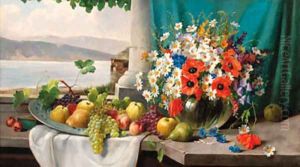Guiseppe Maria Crespi Paintings
Guiseppe Maria Crespi, also known as Lo Spagnuolo (The Spaniard), was an Italian Baroque painter born on March 14, 1665, in Bologna. Crespi's nickname derived from his fondness for the vivid, Spanish-style clothes that he often wore. He is recognized for his distinctive and innovative contributions to the Bolognese School of painting, and he is often considered one of the precursors of the Rococo style.
Crespi received his early training in the studio of Domenico Maria Canuti, but he was also influenced by the Carracci Academy, which was the leading art school in Bologna at the time, promoting a style that combined the robust naturalism of the High Renaissance with the dynamism of the Baroque. However, Crespi's style did not fully conform to the principles of the Carracci; instead, he developed a more personal style characterized by loose brushwork and a warm, rich color palette.
Throughout his career, Crespi showed a remarkable ability to adapt and innovate, which led him to work in various genres. He painted religious and mythological subjects, genre scenes, and portraits. Crespi is particularly noted for his genre scenes, which often depicted common people and everyday life with a sense of intimacy and emotional depth. His works in this genre show a keen observation of light, color, and texture, and they display an empathetic approach to his subjects, which was relatively uncommon for his time.
Crespi also gained recognition for his religious works, which were marked by a similarly intimate approach, often capturing the human and compassionate sides of biblical narratives. His frescoes and altarpieces feature in many important churches in Bologna and other Italian cities.
In addition to his painting, Crespi was also a talented printmaker, and he played a significant role in the development of the mezzotint technique in Italy. His influence extended to his pupils, the most famous of whom was Giovanni Battista Piazzetta, who would become a leading Venetian painter of the early 18th century.
Crespi's work was highly appreciated during his lifetime, and he was patronized by several important Italian families. He continued to paint until his later years, maintaining a high level of quality in his work. Guiseppe Maria Crespi passed away on July 16, 1747, in his hometown of Bologna. Today, his works can be found in major museums across the world, and he is celebrated for his contribution to the evolution of Italian Baroque art.
